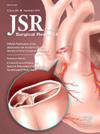Does Functional Status Predict Worse 30-D Outcomes in Endovascular Repair of Abdominal Aortic Aneurysms? A Propensity-Score Matched Study From ACS-NSQIP Targeted Database From 2012 to 2022
IF 1.8
3区 医学
Q2 SURGERY
引用次数: 0
Abstract
Introduction
In patients undergoing endovascular aneurysm repair (EVAR), existing studies have identified an association between dependent functional status (DFS) and poorer outcomes after EVAR. However, noted limitations, especially the lack of differentiation between ruptured and nonruptured abdominal aortic aneurysm (AAA), potentially affect the extrapolation of these findings to specific patient groups. Thus, this study aimed to evaluate the association between functional status and 30-d outcomes after EVAR in ruptured and nonruptured AAA patients separately.
Methods
Patients who underwent infrarenal EVAR were identified in the American College of Surgeons National Surgical Quality Improvement Program targeted database from 2012-2022. Patients with DFS and those with independent functional status (IFS) were stratified into the two study cohorts. In nonruptured AAA, a 1:1 propensity-score matching was used to address demographics, baseline characteristics, aneurysm diameter, distal extent of the aneurysm, anesthesia, and concomitant procedures between patients with DFS and IFS. The sample size for ruptured patients with AAA was too small for meaningful statistical analysis so only qualitative description was provided. Thirty-d postoperative mortality and morbidities of EVAR were assessed.
Results
For nonruptured cases, there were 380 (2.55%) DFS and 14,545 (97.45%) patients with IFS, where 453 patients with IFS were matched to the DFS cohort. For ruptured AAA, there were 17 (6.39%) DFS and 249 (93.61%) IFS. After matching, nonruptured DFS and patients with IFS had similar 30-d mortality rates (2.37% vs 2.11%, P = 1.00). However, patients with DFS had a higher risk of bleeding requiring transfusion (18.42% vs 11.84%, P = 0.01) and longer length of stay (median 3.00 [Q1 1.00, Q3 6.00] vs median 2.00 [Q1 1.00, Q3 4.00] d, P < 0.01). All other outcomes, including major adverse cardiovascular events, cardiac complications, stroke, pulmonary complications, renal complications, sepsis, venous thromboembolism, wound complications, lower extremity ischemia, ischemic colitis, postoperative ruptured aneurysm, unplanned reoperation, 30-d readmission, were not different between patients with DFS and IFS. Qualitatively, ruptured patients with DFS had higher crude rates of 30-d mortality and morbidities compared to patients with IFS.
Conclusions
Contrary to previous literature, patients with DFS with nonruptured AAA undergoing EVAR were found to have largely comparable outcomes to patients with IFS, although extra attention should be paid to postoperative bleeding.
功能状态能否预示腹主动脉瘤血管内修复术的 30-D 恶果?来自 2012 年至 2022 年 ACS-NSQIP 目标数据库的倾向分数匹配研究。
导言:在接受血管内动脉瘤修补术(EVAR)的患者中,现有研究发现依赖性功能状态(DFS)与 EVAR 后较差的预后之间存在关联。然而,研究的局限性,尤其是缺乏对破裂和未破裂腹主动脉瘤(AAA)的区分,可能会影响将这些研究结果推广到特定患者群体。因此,本研究旨在分别评估破裂和未破裂腹主动脉瘤患者EVAR术后功能状态与30天预后之间的关系:方法:从美国外科学院国家外科质量改进计划目标数据库(2012-2022 年)中确定了接受肾下 EVAR 的患者。将DFS患者和有独立功能状态(IFS)的患者分为两个研究队列。在非破裂型 AAA 患者中,针对 DFS 和 IFS 患者的人口统计学、基线特征、动脉瘤直径、动脉瘤远端范围、麻醉和伴随手术,采用了 1:1 倾向分数匹配。AAA破裂患者的样本量太小,无法进行有意义的统计分析,因此只提供了定性描述。对EVAR术后30天的死亡率和发病率进行了评估:在未破裂的病例中,有 380 例(2.55%)DFS 患者和 14,545 例(97.45%)IFS 患者,其中 453 例 IFS 患者与 DFS 患者队列相匹配。对于破裂的 AAA,DFS 患者有 17 人(6.39%),IFS 患者有 249 人(93.61%)。匹配后,未破裂的 DFS 和 IFS 患者的 30 天死亡率相似(2.37% vs 2.11%,P = 1.00)。然而,DFS 患者出血需要输血的风险更高(18.42% vs 11.84%,P = 0.01),住院时间更长(中位数 3.00 [Q1 1.00, Q3 6.00] vs 中位数 2.00 [Q1 1.00, Q3 4.00] d,P 结论:与之前的文献相反,接受EVAR手术的DFS非破裂型AAA患者的预后与IFS患者基本相当,但应格外注意术后出血。
本文章由计算机程序翻译,如有差异,请以英文原文为准。
求助全文
约1分钟内获得全文
求助全文
来源期刊
CiteScore
3.90
自引率
4.50%
发文量
627
审稿时长
138 days
期刊介绍:
The Journal of Surgical Research: Clinical and Laboratory Investigation publishes original articles concerned with clinical and laboratory investigations relevant to surgical practice and teaching. The journal emphasizes reports of clinical investigations or fundamental research bearing directly on surgical management that will be of general interest to a broad range of surgeons and surgical researchers. The articles presented need not have been the products of surgeons or of surgical laboratories.
The Journal of Surgical Research also features review articles and special articles relating to educational, research, or social issues of interest to the academic surgical community.

 求助内容:
求助内容: 应助结果提醒方式:
应助结果提醒方式:


